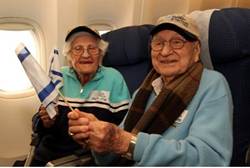
In this handout photo
provided by the Israeli Government Press Office, Nazi criminal Adolf
Eichmann sits in his cell in Galami Prison, waiting for his trial to
open, near Haifa, Israel, in 1960.
TEL AVIV, ISRAEL—Lifting a half-century veil of secrecy, Israel’s
Mossad
spy agency is opening its archive this week to reveal the story behind
the legendary 1960 capture of Nazi mastermind Adolf Eichmann.
The “Operation Finale” exhibit, curated by a Mossad officer who can’t
be fully identified, displays never before seen items, names and
documents that led to Eichmann’s nabbing in Argentina. It also discloses
new details, such as how forensic experts identified Eichmann by his
ears.
Eichmann was in charge of implementing Adolf Hitler’s “final
solution,” the plan to exterminate the Jews of Europe. Six million Jews
were killed by the Nazis and their collaborators during World War II.
The Mossad’s exploits typically become known only when something goes
wrong. This exhibit tells a success story, offering the most
comprehensive picture to date of the complex operation that helped shape
the agency’s image — bringing a top Nazi criminal to justice.
“This is the first time the Mossad carried out a huge operation
overseas, and it had to invent all this ‘James Bond’ stuff in the
process,” said the curator, who can be identified only as Avner A.
because of agency regulations.
“This operation made the Mossad,” he said. “It proved to itself and
to the entire world that it could pull off an operation at the end of
the world with a variety of bodies, under all kinds of identities and
with various technical and technological means.”
Avner said the agency’s tactics and strategies have evolved since
then. Even so, the exhibit was initially intended to remain classified,
but “the Eichmann story is so strong that we just couldn’t keep this one
to ourselves.”
Among the highlights of the exhibit at the
Beit Hatfutsot
museum of the Jewish people in Tel Aviv are the original Mossad file on
Eichmann, code named “Dybbuk” — Hebrew for “evil spirit,” the briefcase
with a concealed camera that took the first pictures of Eichmann in
Buenos Aires, the fake licence plates the agents made for vehicles to
track Eichmann, the gloves used to nab him, the needle used to sedate
him and the forged Israeli passport his captors used to smuggle him out
of Argentina.
Eichmann’s 1961 trial in Jerusalem captivated the country and the
world with gripping public testimony of more than 100 Jews who survived
extreme torture and deprivation in concentration camps and brought to
life the horrors of the Nazi “final solution.”
Eichmann was convicted of war crimes and crimes against humanity and
was hanged the following year, the only time Israel has carried out a
death sentence.
After the war ended in Germany’s defeat, Eichmann escaped American
captivity and fled to Argentina in 1950, assuming the name Ricardo
Klement.
There he kept out of sight until 1957, when his eldest son, Nick, befriended a girl named Silvia.
Her father, Lothar Hermann, was a Holocaust survivor. After becoming
suspicious of the young Eichmann, he dispatched a letter, displayed in
the exhibit, to Fritz Bauer, a fellow Jewish Holocaust survivor, who was
the German state of Hesse’s chief prosecutor. Bauer informed the
Israelis, who started investigating.
Two years later, Mossad agent Zvi Aharoni located the family home on
Garibaldi Street in Buenos Aires and returned with photographs of
Ricardo Klement that matched those taken of Adolf Eichmann. Israeli
forensic experts matched the details of the ears in each photo for final
confirmation.
On the evening of May 11, 1960, a seven-man team waited near the bus
station where Eichmann arrived each evening from his job at a Mercedes
Benz factory.
After Eichmann got off the bus, agent Zvi Malkin jumped on him,
making sure to put his gloved hand inside Eichmann’s mouth, in case he
had a cyanide pill hidden inside a tooth as some former top Nazis were
known to have in case of capture, Avner said.
Two agents helped shove Eichmann into the getaway car where a fourth agent, Aharoni, awaited.
“If you move,” Aharoni told Eichmann, “you will be shot in the head,” according to the Mossad exhibit.
Eichmann mumbled back in German: “I accept my fate.”
The exhibit also showcases the personal effects found on Eichmann’s
body — a comb, a pocket knife and a plastic cigarette holder.
Eichmann was held in a safe house for nine days until the group flew
out in an El Al Israel Airlines plane that had brought an official
Israeli delegation to mark Argentina’s 150th anniversary. Eichmann was
drugged, dressed in an El Al uniform, seated in first class and passed
off as a crew member who was ill.
The operation was so secret that even diplomat Abba Eban, who later
became Israel’s foreign minister, had no clue he was providing cover for
a plane to return to Israel with Eichmann and the Mossad team, leaving
Eban and other diplomats behind.
In researching the operation, Avner said he made several new
discoveries. For instance, there was a Plan B, should the airlift fail,
to smuggle Eichmann in a freighter ship transporting frozen meat, and
even a Plan C that called for him to be dropped off at a halfway house
in Europe before a final trip to Israel.
Avner even found the Israeli optometrist who agreed to prepare
glasses for Eichmann, after his original pair were broken during his
capture. The glasses were made of plastic to prevent Eichmann from using
glass to slit his wrists.
“The more I discover new details, the more I realize that I don’t
have the full story,” said Avner, before adding. “We’ll probably never
truly know the full story.”
http://www.thestar.com/news/world/article/1128268--israel-s-mossad-spy-agency-reveals-story-behind-1960-capture-of-adolph-eichmann-in-argentina






















































